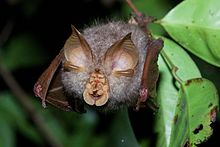Trefoil horseshoe bat
| Trefoil horseshoe bat | |
|---|---|

| |
| Scientific classification | |
| Domain: | Eukaryota |
| Kingdom: | Animalia |
| Phylum: | Chordata |
| Class: | Mammalia |
| Order: | Chiroptera |
| Family: | Rhinolophidae |
| Genus: | Rhinolophus |
| Species: | R. trifoliatus
|
| Binomial name | |
| Rhinolophus trifoliatus Temminck, 1834
| |

| |
| Trefoil horseshoe bat range | |
The trefoil horseshoe bat (Rhinolophus trifoliatus) is a species of bat in the family Rhinolophidae. It is found in Brunei, India, Indonesia, Malaysia, Myanmar, Singapore, and Thailand. In Borneo locally common up to 1,800m, including mangroves.[2]
Description
Rhinolophus trifoliatus is a medium-sized horseshoe bat (forearm 47-52mm, 10.5-18 grammes)[3] This bat has fluffy, pale grey fur, with a yellow nose leaf and ear membranes.[2]
Ecology and Behaviour
R. trifoliatus is caught in the understory of primary and secondary rainforest.[3] This species is thought to be solitary, with individuals observed roosting hanging underneath exposed leaves. As with the neotropical Ectophylla alba it is thought that their pale fur may be an adaptation to make them camouflaged when roosting, as sunlight filtering through the leaf will make them appear green.
External links
References
- ^ Hutson, A.M.; Kingston, T.; Francis, C.; Molur, S.; Srinivasulu, C. (2008). "Rhinolophus trifoliatus". The IUCN Red List of Threatened Species. 2008. IUCN: e.T19574A8980740. doi:10.2305/IUCN.UK.2008.RLTS.T19574A8980740.en.
{{cite journal}}: Unknown parameter|last-author-amp=ignored (|name-list-style=suggested) (help) - ^ a b Phillips, Quentin and Phillips, Karen (2016). Mammals of Borneo and their Ecology. ISBN 9789838121668
- ^ a b Payne, Junaidi and Francis, Charles (1985). A Field Guide to the Mammals of Borneo. ISBN 9679994716

